President Reagan Laid to Rest
I was out last night and fully expected to miss the burial services but, owing to the time difference, returned to a television set just in the nick of time. In many ways, the service at the Reagan Library was better than the grand affair at the National Cathedral. The speeches were less polished and the preacher prattled on too long, but seeing the Reagan kids–finally seeming grown up and cognizant of their father’s stature–come together to comfort their mother and pay tribute to their departed dad was quite nice. And Nancy was finally free to grieve, no longer having days of public spectacle to face.
LA Times — Reagan Buried at His Library
Ronald Wilson Reagan, the nation’s 40th president, was buried on a golden Southern California hilltop Friday, after a funeral in Washington National Cathedral attended by hundreds of world leaders, past and present.
The ceremonies ended a week of mourning and majesty that honored the uniquely American figure who was credited with hastening the end of the Cold War. Reagan died June 5 at 93.
A presidential jet delivered his body to California, where the former statesman and showman was laid to rest in a horseshoe-shaped burial site at the Ronald Reagan Presidential Library — shaded by seven oak trees and overlooking a panoramic farm valley, with the Pacific Ocean beyond.
The day began in the gray mist of a Washington drizzle and ended in the glow of a California sunset. Formal tributes in the nation’s capital gave way to the more intimate embrace of the Santa Susana Mountains and the tender memories of the children who loved him.
Michael Reagan spoke of his father’s gift of Christian faith and his advice on how to have a long and happy marriage: “You’ll never get in trouble if you say ‘I love you’ at least once a day.”
Patti Davis recounted how the man who would be president taught his daughter about death by helping her bury her goldfish.
And Ronald Prescott Reagan talked about his father’s optimism, his struggle with Alzheimer’s disease and his last trip home: “In his final letter to the American people, Dad wrote: ‘I now begin the journey that will lead me into the sunset of my life.’ This evening, he has arrived.”
NYT — For a Frail Mrs. Reagan, a Week of Great Resolve [RSS]
Nancy Reagan started her seventh day of mourning Friday bowed over her husband’s coffin in the Rotunda of the Capitol. By the time the sun set in California 12 hours later, Mrs. Reagan had attended a state funeral at National Cathedral, a formal send-off at Andrews Air Force Base and, after a cross-country flight aboard an Air Force jumbo jet, Ronald Reagan’s burial on a hillside outside Los Angeles.
For Mrs. Reagan, it was an exhausting and emotional test of endurance, all the more so for an 82-year-old woman who, as friends noted, for 10 years has barely been able to step out for lunch as she cared for her ailing husband. It ended at dusk in California as she wept softly over her husband’s coffin with her children at her side. It was also the climax of a meticulously planned week of pageantry and tribute that Mrs. Reagan was, characteristically, intimately involved in arranging, right down to the selection of the tenor who sang “Ave Maria” at the cathedral on this rainy morning.
Mrs. Reagan’s friends said she was, to no small extent, shielded from the emotion of her loss as she watched, with evident pride and sorrow, as every motorcade, eulogy, and snap of a salute that made up a memorial unlike any Washington had seen in 50 years unfolded almost precisely as planned.
“She looks a little frail,” said Betsy Bloomingdale, a close friend of Mrs. Reagan, speaking from her home in California as she prepared to attend the burial there Friday night. “But she is very strong inside. She is. She has the strength. She is doing her last thing for Ronnie. And she is going to get it right.”
Mrs. Reagan’s friends were not alone in talking of her composure and resolve this week, on display from the intimate first service at the Ronald Reagan Presidential Library on Monday, where the former first lady brushed the coffin with her cheek, through a state funeral that drew every living president and leaders from around the globe. But they said it, like everything else involving the former first lady this week, was testimony to Mrs. Reagan’s fastidiousness and the attention she had always paid to the details of her husband’s life.
There were, as she intended, no surprises here.
“She was determined to get through this,” said another friend of the family’s, who asked not to be identified. “It’s the role she’s been given to play. It’s her last thing for him.”
The planning began while Mr. Reagan was still in the White House and continued with regular meetings through the years. It was Mrs. Reagan, a friend said, who asked that former President George Bush speak at the funeral, who chose the chorus that would sing, and who helped devise what amounted to an elaborate cross-country funeral timed to the setting of the sun over the Pacific Ocean.
One of her friends noted, after the funeral ended here, that the service could not have been more punctual, making sure that the Boeing 747 carrying Mr. Reagan’s body would beat the sunset.
For Mrs. Reagan, these few days marked a period of visibility and demand on her unlike anything she has experienced since her husband left office in January 1989.
She flew back and forth across the nation. She attended four public ceremonies marking her husband’s death. During less than 48 hours in Washington, while she stayed at Blair House across Pennsylvania Avenue from the White House, she accepted sympathy calls from, among others, President Bush, Margaret Thatcher and Mikhail S. Gorbachev.
For Americans whose last vivid memory of Mrs. Reagan was delivering a speech in his honor at the 1996 Republican presidential convention the past few days provided a blur of sorrowful images of a woman who seemed too stunned to cry, and who was so frail that one friend described her as “nothing more than skin and bones.”
After the ceremonies in Washington, and the motorcade back to Andrews Air Force base outside Washington, Mrs. Reagan walked uncertainly up the stairs to the Air Force 747 with the United States of America emblem on the side transporting her husband’s coffin home. She had had almost slipped through the door when she stopped and turned around.
Mrs. Reagan looked to the crowd and the cameras, removed her oversize glasses, and with a whisper of a sad smile, waved her hand and blew a kiss in a final salute to Washington. It was as if it were more than 15 years ago, and her husband the president was back at her side as they boarded Air Force One.
“A lot of what’s going on here is she is in a lot of shock and you kind of put one foot in front of he other,” said Sheila Tate, her friend and former press secretary. “I’ve just been amazed at how well she’s held together.”
“She’s always risen to the occasion,” Ms. Tate said. “When he got shot. When he got cancer. When she got cancer. She’ll be fine.”
Her friends said that it was unthinkable that Mrs. Reagan would lose control of her emotions in the midst of a memorial that she took such care to help plan. Yet they described moments of stability that they could not begin to fathom. How she never lost her composure, at least in public. How she appeared to be comforting President Bush, as much as he comforted her, when he escorted her the final few steps to her seat at the Washington Cathedral.
How on her unsteady walk down the aisle and out of the church again, this small, slightly stooped figure, appearing alone even in a church filled with thousands of people who would call themselves her friend, she looked back and forth, murmuring “thank you” to those who had come.
“She behaved with great grace and dignity,” said Myra Gutin, an expert on first ladies at Rider University in New Jersey for 20 years. “For me it was reminiscent of Jacqueline Kennedy at J.F.K.’s funeral. The same sense of grace and forbearance.”
In the White House, Mrs. Reagan endured criticism as being too controlling and, at times, manipulative, historians said. But that perception has eased over the years, and perhaps more so than ever over the last few days.
“It’s really a passage for her as much as it was for her husband,” said Lewis Gould, a University of Texas historian emeritus who is editing a biography series, “Modern First Ladies.” “She’s moved into the same category that Lady Bird Johnson has: a revered, grande dame of public life.”
Some of Mrs. Reagan’s friends said they expected that she would be urged by Republicans to play a role at the party’s convention in two months, or in Mr. Bush’s re-election campaign. But friends said that the former first lady was unlikely to accept such partisan invitations.
“She will focus on the Reagan legacy and not partisan politics,” said Kenneth Duberstein, who was chief of staff in Mr. Reagan’s White House.
Casey Ribicoff, a friend of Mrs. Reagan’s, and the widow of former Senator Abraham A. Ribicoff, who also suffered from Alzheimer’s Disease, said that Mrs. Reagan would probably spend weeks responding to the outpouring of mail to her over the last few days.
“I have no doubt that Nancy will rest and sort things out,” Mrs. Ribicoff said. “When reality sets in, that’s when you become exhausted.”
LA Times — Lasting Memories Gleaned Along the Final Leg
As thousands of mourners lined the route, Ronald Reagan ended his long journey Friday with a stately 28-mile procession through a California landscape of farmland, freeways and suburbs.
Throngs of well-wishers had planted themselves at viewing spots hours before the plane bearing Reagan’s flag-draped casket touched down at Point Mugu Naval Air Station. Proceeding at a solemn pace, the limousine convoy of security officers, family members and dignitaries left the base at 5:05 p.m. and arrived at the Ronald Reagan Presidential Library near Simi Valley about 90 minutes later.
Along the way, the 40th president’s entourage rolled past cabbage fields and condominiums, peering out at crowds who saluted, waved flags and held their small children up to see a slice of history.
Sporting U.S. flag earrings, Nancy Goguen of Calabasas and her whole family were decked out in red, white and blue as they waited.
“Coming out here for us crosses political lines,” said Goguen, a retired school secretary and lifelong Democrat. “It has to do with showing support for a really good man.”
At the naval base at Point Mugu, more than 1,000 employees silently gathered on the tarmac as Reagan’s casket was borne to his hearse by a military honor guard.
When Nancy Reagan emerged from the plane, the crowd erupted with shouts of “We love you, Nancy!” Appearing weary, she waved and smiled before slowly descending the ramp.
Outside the base’s gates, the procession glided through the tilled green fields lining Las Posas Road toward the mountains in the distance.
At a fruit stand amid fields of sod, several hundred spectators gazed down the road as a U.S. flag and a banner emblazoned with a strawberry fluttered at half-staff. When the motorcade’s California Highway Patrol motorcycle escort approached with blue lights flashing, some onlookers clambered onto car roofs. One woman wrapped a pillowcase around her waist with the hand-painted words: “God bless.”
Spectators jammed overpasses spanning the Ventura Freeway. Outside shopping centers and subdivisions, they jammed the sidewalks, eager for a last chance to pay tribute.
In Camarillo, crowds stood five-deep in spots, with many people toting children, video cameras and flags. For those without the American symbols, two vendors circulated through the throng, hawking them at $5 each.
Matt Lorimer, 36, of Camarillo carried a sign that said “Stem Cells Yes,” a nod to Nancy Reagan for her recent advocacy of the controversial research.
His 4-year-old son, Miles, has autism and can’t yet speak. Advocates say stem-cell research may help in the struggle against autism and Alzheimer’s disease, which afflicted Reagan.
At Spring Meadow Park in Thousand Oaks, neighbors set up lawn chairs and dipped into coolers for sodas and wine. On a blanket under a shade tree, seven children listened raptly as Rena Roberts, 35, of Newbury Park read to them about Abraham Lincoln from a book called “True Stories of Great Americans.”
Roberts, a friend and their children had arrived in the park seven hours earlier to get front-row seats for the motorcade. When it had passed, a man nearby played “God Bless America” on his trombone.
Near Los Robles Regional Medical Center, John McCauley, 50, joined the crowd. His wife, Stacy, 34, had given birth to a girl shortly before noon and insisted that John snap a photo of the passing funeral procession for their newborn’s scrapbook.
When his daughter is older, McCauley said, he would tell her how “one of the most popular presidents of all time passed by the hospital on the day you were born.”
The Westlake Village resident would also tell her how he and his wife had spontaneously decided on little Ella’s middle name.
“I said, ‘Why not Reagan?’ ” McCauley said. “And she said, ‘That’s awesome.’ “
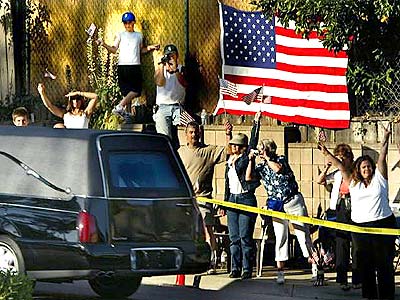
The hearse carrying the body of Former President Ronald Reagan makes its way on Lynn Road in Thousand Oaks heading for the Reagan Presidential Library for funeral services.(Anne Cusack / LAT)
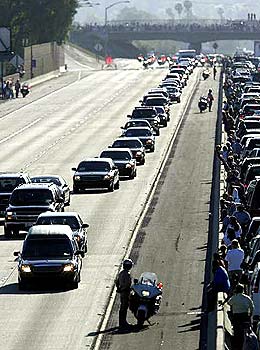
Thousands line the route of the 101 Freeway to watch the motorcade carrying the remains of former President Reagan from Point Mugu naval base to the Reagan Presidential Library in Simi Valley.
(Ricardo DeAratanha / LAT)
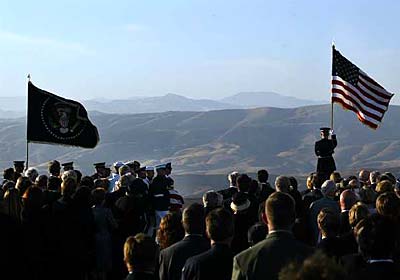
An honor guard carries the flag-draped casket of former President Reagan during final services at the Reagan Presidential Library in Simi Valley.(Spencer Weiner / LAT)
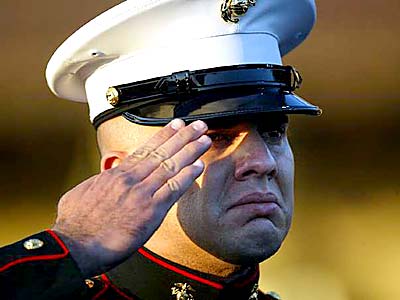
Marine Sgt. Ethan Rocke weeps as he salutes the Honor Guard carrying
the flag-draped casket of former President Reagan (Spencer Weiner / LAT)
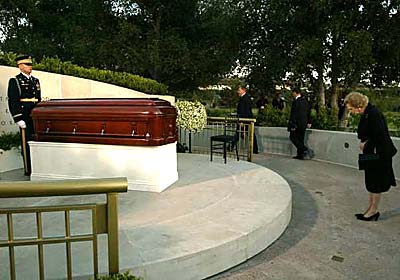
Former British Prime Minister Margaret Thatcher bows before the casket of former President Reagan at his burial site at the Reagan Presidential Library in Simi Valley. (Bryan Chan / LAT)
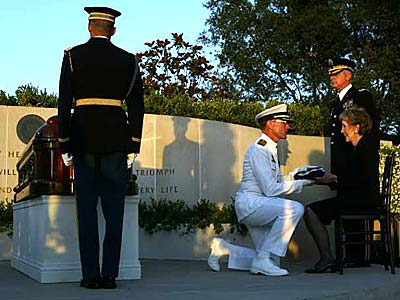
Navy Capt. James Symonds presents the U.S. flag to former First Lady Nancy Reagan. The flag covered the casket of her husband, former President Reagan. (Bryan Chan / LAT)
Late roundups of the services at the National Cathedral:
LA Times — Eulogies Praise Ideals and Legacy
President Bush’s eulogy for Ronald Reagan on Friday was uplifting, but determinedly nonpolitical. His father, former President George H.W. Bush, was personal and emotional, mingling affectionate jokes with tears.
But it was former British Prime Minister Margaret Thatcher who delivered the bluntest message about Reagan’s conservative political legacy during the funeral at Washington National Cathedral.
“Others saw only limits to growth,” Thatcher, long Reagan’s closest ideological ally abroad, said in a videotaped tribute. “[Reagan] transformed a stagnant economy into an engine of opportunity. Others hoped, at best, for an uneasy cohabitation with the Soviet Union; he won the Cold War.”
As the week of mourning for Reagan drew to a close, the debate over the 40th president’s place in history briskly resumed — with conservatives lauding his accomplishments and liberals arguing, a bit gingerly, that his record also had flaws.
But that is what happens whenever a well-loved president dies, historians said. If Republicans hold Reagan up as an icon and dedicate their national convention in New York this summer to his memory, they will be doing the same thing Democrats did after the deaths of Franklin D. Roosevelt in 1945 and John F. Kennedy in 1963.
“What you’re seeing is the first brushstrokes of history,” said historian Robert Dallek, who wrote biographies of Kennedy and Reagan. “You get these opening salvos, both pro and con; then things settle down.”
At the cathedral, where the elaborate protocol of a state funeral combined with traditional Episcopal rites, the tone was solemn and restrained — the opposite of the heated partisan debates that dominated Reagan’s long political career.
President Bush focused on Reagan’s ideals, his grace and his religious faith, and touched only lightly on his politics — to praise his role as leader of the modern conservative movement in American politics.
“In the space of a few years, he took ideas and principles that were mainly found in journals and books, and turned them into a broad, hopeful movement ready to govern,” Bush said.
“President Reagan was optimistic about the great promise of economic reform, and he acted to restore the reward and spirit of enterprise,” Bush said, apparently referring to Reagan’s tax cuts. “He was optimistic that a strong America could advance the peace, and he acted to build the [military] strength that mission required.”
But where Bush carefully avoided any temptation, during an election year, to link Reagan’s causes with his own, Thatcher, who is no longer running for office, showed no hesitation in pressing the ideological advantage.
“[Reagan] had firm principles — and, I believe, right ones,” she said in her tribute, which she videotaped several months ago after a series of small strokes made it difficult for her to speak in public.
“He did not shrink from denouncing Moscow’s ‘evil empire,’ ” she said. “But he realized that a man of goodwill might nonetheless emerge from within its dark corridors. So the president resisted Soviet expansion and pressed down on Soviet weakness at every point, until the day came when communism began to collapse beneath the combined weight of these pressures and its own failures. And when a man of goodwill did emerge from the ruins, President Reagan stepped forward to shake his hand and offer sincere cooperation.”
The “man of goodwill” she cited, former Soviet President Mikhail S. Gorbachev, was also in the congregation at the funeral, but was not among those chosen to deliver a eulogy.
Gorbachev has praised Reagan’s role as a peacemaker, but he has long objected to the argument — made by Thatcher and other conservatives — that Reagan’s military buildup produced the collapse of communism.
“All that talk that somehow Reagan’s arms race forced Gorbachev to look for some arms reductions, etc., that’s not serious,” Gorbachev told the Washington Post this week. “The Soviet Union could have withstood any arms race.”
Instead, Gorbachev said, he decided to reform the communist system because it was failing economically. “The country was being stifled by the lack of freedom,” he said. “We were increasingly behind the West.”
Dallek said Thatcher’s retelling of the Reagan era struck him as “out-and-out partisan history,” but added: “That’s what happens at a time like this: Politicians appropriate whatever part of the history they want to use, and invoke it.
“It’s not fabrication as much as gilding the lily. It’s hagiography, and it’s sort of inevitable,” he said. “We’re nowhere near being able to see a balanced picture of Reagan, because it’s only 15 years after he left office. We don’t have the [internal White House] documents yet.”
Another historian, Barton J. Bernstein of Stanford University, said a similar phenomenon occurred after the death of another well-loved president, Kennedy, who was assassinated in 1963.
“The first books written about Kennedy were written by men who had worked for him, like Arthur M. Schlesinger Jr. and Theodore Sorensen,” Bernstein said. “They were in the unusual position of being both participants and historians of the events in which they participated … and their work was eloquent but, let’s say, flawed.”
Even today, according to the Gallup Poll, Kennedy is ranked by most Americans as the greatest president of modern times, though he was in office for less than three years. Reagan comes in second.
But Reagan was not always so popular. When he was in office from 1981 through 1989, his average approval rating was 53% — “slightly below average” for modern presidents, Gallup reported this week.
After he left office, Reagan’s approval in voters’ eyes ranged between 50% and 54%, Gallup said, until the announcement in 1994 that he was suffering from Alzheimer’s disease. After that, the former president rose significantly in Americans’ eyes.
But Dallek said he thought it was not only sympathy that won Reagan higher standing.
“The last 15 years or so have been a period of great acrimony in our politics,” he said. “Reagan had a gift for inspiring people with the idea that Americans, no matter what their politics, have shared values and that the country has a bright future.”
In this election year, Dallek said, Reagan’s image as a unifier has been enough to make him more popular than he was when he was in office.
WaPo — Reagan Hailed as Leader for ‘the Ages’
A poor kid in the America that Ronald Reagan extolled could end up a movie star, a millionaire, president of the United States — or, in his case, all three. That storybook life turned its last page yesterday with a funeral fit for a king.
Beneath the towering vaults of Washington National Cathedral, about 3,700 mourners — leaders of government, heads of state, captains of industry, brokers of power — sat rapt as the 40th president, who died last Saturday at 93, was commemorated by his admirers and commended to his God.
The pomp was nearly unprecedented in American annals, more than two extraordinary hours of thundering organ, swelling chorus, haunting silences and eloquent prayers. Eulogies were spoken by two presidents and two prime ministers.
“Ronald Reagan belongs to the ages now,” said President Bush, echoing words once spoken upon the death of Abraham Lincoln, “but we preferred it when he belonged to us.”
After the funeral, the late president’s body rode one last time to Andrews Air Force Base and one last time home to California aboard a presidential jet. He was buried near sunset on the grounds of the Reagan Presidential Library in Simi Valley, in a simple service featuring tributes from his three surviving children. Former first lady Nancy Reagan, stoic through nearly a week of somber rituals, surrendered to her grief after being handed the flag that had covered her husband’s coffin.
So ended the nation’s farewell to a man judged by fans and critics alike to have ranked among the most consequential presidents of the past century, a man credited by former British prime minister Margaret Thatcher yesterday with having “won the Cold War.”
Washington’s first state funeral in more than 30 years — the first held in the cathedral since 1969 — came off without incident and caused less disruption than some had feared. Security at the invitation-only ceremony was tight but not oppressive, and D.C. police reported few traffic jams despite the comings and goings of scores of motorcades. Crowds along the route from the Capitol, where more than 100,000 people visited Reagan’s coffin as it lay in state, were easily managed.
Under gray, sprinkling clouds, a time capsule opened, and out stepped the men and women who strove and clashed, rose and fell, won and lost in an age that seems long ago and far away. Former president Gerald R. Ford, who beat back Reagan’s bid for the 1976 Republican nomination, chatted with former president Jimmy Carter, who lost to Reagan four years later.
The small, aged frame of former defense secretary Caspar Weinberger belied a handshake still tight as a vise grip. Former secretary of state Alexander Haig still likes his suits cut snug and styled a bit flashy.
In from the cold came such sinning Reaganauts as budget director David Stockman, who spilled the beans on the Reagan administration’s failure to pay for its tax cuts, and national security adviser Robert McFarlane, who executed the arms-for-hostages exchange that became known as Iran-contra. Welcomed inside was former representative Kent Hance of Texas, a card-carrying Reagan Democrat who once whipped a young challenger named George W. Bush.
Bygones were bygone.
At least they were inside the cathedral, where United Nations Secretary-General Kofi Annan, who opposed the Iraq war, chatted animatedly before the service with the pro-war British prime minister, Tony Blair. Outside, there were a few protesters scattered among the curious and the reverent along Wisconsin Avenue NW. The District’s Anti-War Network, for example, held signs cataloguing Reagan’s “victims”: the poor, El Salvador, people with AIDS and so on.
In his eulogy, President Bush noted that Reagan was never afraid of controversy; indeed, he was the standard-bearer of a conservative assault on the New Deal orthodoxy that once dominated Washington.
Thatcher concurred: “Ronald Reagan knew his own mind,” she said in a tribute videotaped several years ago when her voice began failing. It was played in the cathedral as she sat listening, her face fixed in that familiar look of steely dignity. “He had firm principles and, I believe, right ones. He expounded them clearly. He acted upon them decisively.”
But a state funeral is only partly about a president. It is also about a nation. Depending on the planners and the times, the rituals can emphasize majesty or the common touch. Reagan and his supporting crew were masters of every variety of public event; they put Hollywood’s production values at the service of the presidency as never before. The president who promised to restore American greatness and confidence was especially partial to the sweeping, the stirring, the spectacular.
So his team pulled out all the stops.
A funeral years in the planning — Nancy Reagan met every six months or so with key advisers to update preparations — began with the gradual arrival of the guests, who had colored dots discreetly marked on the back of their tickets. Black dots sat way in the back; status-conscious Washingtonians soon figured out that orange was better, red better still and yellow quite exalted. Twenty-five heads of state converged on the cathedral, and 11 former heads of state, and 180 ambassadors or foreign ministers.
At 10 a.m., the U.S. Marine Corps Chamber Orchestra began playing Bach, but the crowd kept talking, glad-handing, back-slapping old friends, strange bedfellows and would-be allies. Many people fell naturally into the capital’s distinctive conversational pose: side by side but facing slightly apart, talking to one another while scanning the room for bigger fish.
The floral displays were enormous and profuse, like small white trees. The sea of dark suits was dotted with ceremonial robes on foreign leaders and a few women in GOP gold.
By 10:20, the former presidents had arrived: Ford, Carter, the elder George Bush and Bill Clinton, who rested his hand on Afghan President Hamid Karzai’s shoulder as his Supreme Court appointees, Stephen G. Breyer and Ruth Bader Ginsburg, chatted nearby.
At 10:45, the crowd was called to its seats as the orchestra played a segment of Mozart’s “Requiem.” The U.S. Armed Forces Chorus launched into two lush and complex anthems by the English composer William H. Harris; soon, the enormous church filled with the buttery tenor of Ronan Tynan singing Schubert’s “Ave Maria.”
Then a hush descended. Discreetly placed television monitors showed the arrival outside of the hearse bearing Reagan’s coffin and the motorcade carrying his family. A bell tolled once, hauntingly. The faint sound of “Ruffles and Flourishes” was heard from outside, and the congregation rose as one for “Hail to the Chief” at dirge tempo.
The official service started five minutes ahead of schedule, and by 11:27, the coffin, weighing more than 700 pounds, was moving slowly down the center aisle, borne by eight strong servicemen. They moved in silence, led by two boys and a girl bearing the cross and candles, then by the Joint Chiefs of Staff decked with ribbons and stars. The Reagan family arrived last, as the coffin was placed on a red bier in the center of the cathedral, Reagan’s head to the west.
Rabbi Harold Kushner, author of “When Bad Things Happen to Good People,” read a passage from the Book of Isaiah, first in Hebrew then in English. Justice Sandra Day O’Connor, appointed by Reagan to be the first woman on the U.S. Supreme Court, read from John Winthrop’s 1630 sermon to his fellow Pilgrims aboard the Arabella bound for Massachusetts Bay Colony.
“We shall be as a city upon a hill,” she intoned — one of Reagan’s favorite images — “the eyes of all people are upon us.”
Quite powerful — but, as Reagan liked to say, you ain’t seen nothing yet. After two verses of the elegant hymn “Jerusalem” sung by the Cathedral Choir, the organ roared to life and the boy sopranos floated their ineffable descant into the ether. Thatcher’s face then appeared on the monitors to deliver her accounting of the work she and Reagan did together.
“Ronald Reagan was such a cheerful and invigorating presence that it was easy to forget what daunting historic tasks he set himself,” she said. “He sought to mend America’s wounded spirit, to restore the strength of the free world and to free the slaves of communism. These were causes hard to accomplish and heavy with risk. Yet they were pursued with almost a lightness of spirit.”
Former Canadian prime minister Brian Mulroney portrayed an affable and humble friend. Former president George H.W. Bush got the congregation laughing. He remembered that Reagan once was asked, “How did your visit go with Bishop Tutu?”
“He replied, ‘So-so,’ ” Bush said.
Bush also choked up, briefly, when he tried to sum up his personal relationship with a man he had battled for the 1980 Republican nomination. “As his vice president for eight years,” Bush said, “I learned more from Ronald Reagan than from anyone I encountered in all my years of public life. . . . He fought hard for his beliefs. But he . . . never made an adversary into an enemy.”
The elder Bush emphasized qualities of kindness, humility and good manners. His son, speaking in the same cathedral where he rallied the nation to war after the attacks on the World Trade Center and the Pentagon, chose to stress Reagan’s resolve in the face of criticism.
“He acted to defend liberty wherever it was threatened. . . . When he saw evil camped across the horizon, he called that evil by its name,” the president said. “There were no doubters in the prisons and gulags where dissidents spread the news, tapping to each other in code what the American president had dared to say. There were no doubters in the shipyards and churches and secret labor meetings where brave men and women began to hear the creaking and rumbling of a collapsing empire.”
Soon, the stony expanse of the cathedral was ringing with the “Battle Hymn of the Republic” — not some somber version, but the rousing arrangement made popular by the Mormon Tabernacle Choir. Former senator John Danforth of Missouri, an Episcopal priest, called on Americans to bring light to a world dark with terror and chaos. Tynan gloried in the old hymn “Amazing Grace.” The congregation lost its voices in the organ ebullient “Ode to Joy.”
And, to muffled drums, the flag-covered coffin was carried back into the day.
Near 1 p.m., the cathedral began to empty. President Bush stopped to shake hands with his predecessor, Clinton. Bush’s opponent in the bitter election of 2000, Al Gore, left his seat in front of Bush political strategist Karl Rove. Liberal Kennedys filed out not far from proto-conservative William F. Buckley Jr. Left and right, old and young, high and low: Just behind comedian Joan Rivers walked Polish anti-communist hero Lech Walesa.
So much symbolism, you might say.
Yet, as Mulroney explained, quoting former French president Francois Mitterand, being president of the United States is not just a job; it is a role. In death as in life, Ronald Reagan reminded the world that symbols matter.

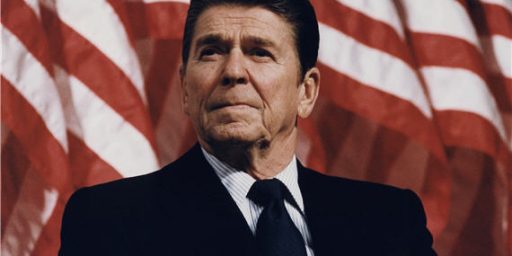
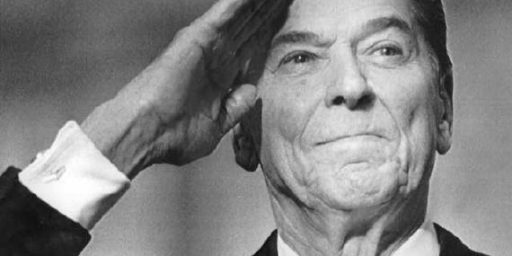
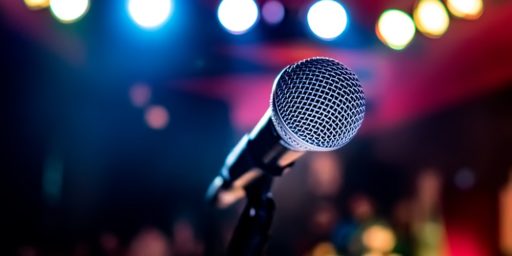
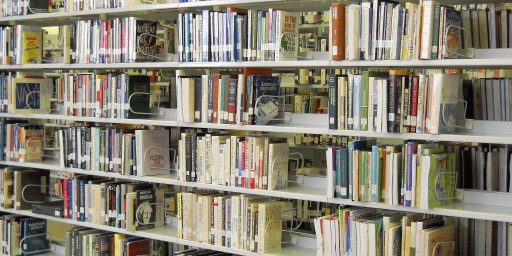
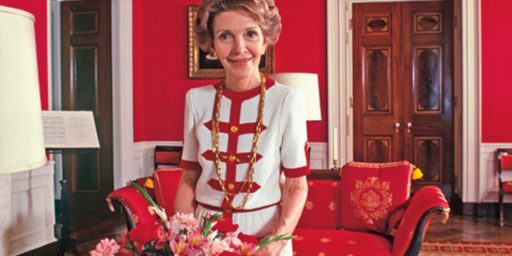
I have to say, the preacher in California was an extraordinary doofus. Aside from every other pompous statement (did he realize the occasion was about Reagan and not about himself?) he stood there and imitated Margaret Thatcher with her in the audience! Mimicked her words in a falsetto voice, complete with bad imitation of her British accent! That was a real cringe-maker.
Thank you Teri, I couldn’t have said it better myself..Cringe, I did..when that silly preacher man began to mouth off, about himself..and do his party imitation of ‘Maggie’…I actually had to turn my TV sound down..to compose myself..and not listen to his drivel..The only excuse was that he is an old fool, just taking his moment in the sun..but his timing was really off!Apart from that
I loved every moment of it all, even Maggie Thatcher’s long winded, but well meaning remarks.
My only regret is that it stayed with me all night long..like a never ending, perfectly produced movie I had watched for a whole week long!
I really thought that Ron Reagan did and outstanding job speaking at his father’s burial service on Friday night. Does anyone know where I can get a transcript of it?
I felt so sorry for Mrs. Reagan, how exhausted she must have been and then she had to suffer through that arrogant “doofus” go on and on and on and on. I did not think he was ever going to stop.